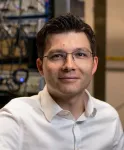(Press-News.org) A new paper in the Quarterly Journal of Economics, published by Oxford University Press, finds that a new form of digital technology—essentially preventing people from using an asset for which they have a loan if they don’t make payments, rather than repossessing the asset itself—may be a better way for lenders to secure loans, particularly for loan recipients in developing countries.
Using collateral to secure debt helps overcome economic frictions, lowering the cost of providing credit. More than 80% of total household debt in the United States is secured by a physical asset. Yet, secured debt is much less common in low- and middle-income countries. This is because property rights are difficult to establish and enforce in economies with weak legal institutions. This translates to a high cost of repossessing collateral for creditors. This is especially true for lenders servicing households in remote areas, where the costs associated with locating and repossessing collateral can be very high.
Poor households, which often lack savings, often have a hard time borrowing money. Recent technological innovations have facilitated new financial contracts that use digital collateral. An emerging example is pay-as-you-go (PAYGO) financing. The typical PAYGO contract requires a small down payment for the borrower to take possession of an asset, followed by frequent, small payments made via a mobile payment system. To screen borrowers and encourage repayment, PAYGO lenders rely on lockout technology. This enables the lender to disable the flow of services from the asset remotely. Disabling the flow of services from digital collateral is cheap and easily reversible. If a farmer uses a loan to purchase a tractor and fails to make on-time payments, the lender won’t come take back the tractor; the lender will just stop the tractor from working until the borrower starts paying his loans again.
In this study, researchers partnered with a large solar-home system provider in Uganda. The company’s small-scale solar home system provides a household with access to a modest amount of electricity without being connected to the grid. Fenix offers PAYGO financing for its services. It also offers follow-up loans for good payers. The study examined the effects of digital collateral with Fenix's most popular follow-up product: a cash loan offered to customers near the beginning of each school term, when children’s school fees are due.
The researchers found that securing loans with digital collateral leads to positive selection, the take-up rate was about 7 percentage points lower for customers offered a (digitally) secured loan than those offered an unsecured loan (44% vs 51%). They also found that securing a loan with digital collateral increased loan repayment and profitability significantly. Securing the loan with digital collateral increased average repayment after 200 days by 11 percentage points over the unsecured repayment rate of 62%. Furthermore, the fraction of households that fully repaid the secured loan was 19 percentage points higher than for unsecured loans. Furthermore, the study found that the school-fee loan increased school enrollment and attendance. Children in households that were offered a school-fee loan were significantly more likely to be enrolled at school compared to children in the control group. The loan offer increased the likelihood that each child would be enrolled by 3 percentage points (from 88% to 91%).
The researchers note that digitally secured collateral programs are becoming more common. A company called Pay Joy, which offers this type of loan for consumers in developing countries, has large scale operations in Mexico, and a growing customer base around the world. In India, digitally secured lending for smartphones is common, especially among two of the largest consumer lenders, Bajaj Finserv and TVS Credit.
The practice is even growing in developed countries. Creditors have deployed digitally secured loans in the United States for subprime auto loans. Manufactures have installed starter interrupt devices, which allow the lender to remotely disable the car if the borrower is not in good standing on the loan, in more than two million vehicles. Recently, Ford Motor Company filed for a patent on a technology that can disable features when borrowers are delinquent on auto loan payments.
“With the proliferation of smart devices, secured lending via digital collateral could easily be extended to a wide range of devices such as laptops, refrigerators, and televisions,” said the paper’s lead author, Paul Gertler.
The paper, “Digital Collateral,” is available at https://academic.oup.com/qje/article-lookup/doi/10.1093/qje/qjae003.
Direct correspondence to:
Paul Gertler
Professor of Economics
Haas School of Business
University of California
Berkeley, California 94705
gertler@berkeley.edu
To request a copy of the study, please contact:
Daniel Luzer
daniel.luzer@oup.com
END
Do digital technologies offer a better way to loan people money?
2024-02-06
ELSE PRESS RELEASES FROM THIS DATE:
Fiona M. Watt receives the 2024 ISSCR Achievement Award for her seminal work with skin stem cells
2024-02-06
Evanston, IL—The International Society for Stem Cell Research (ISSCR) will award its 2024 ISSCR Achievement Award to Fiona M. Watt, D.Phil., F.R.S., F.Med.Sci., EMBO Director and leader of a research group at EMBL - Heidelberg, Germany. The award recognizes the transformative body of work of an investigator that has had a major impact on the field of stem cell research or regenerative medicine. Dr. Watt will present her research during Plenary VII on 13 July at the ISSCR 2024 Annual Meeting in Hamburg, Germany. ISSCR 2024 is the world’s leading gathering of the brightest minds in stem cell research and cell and regenerative medicine.
“Fiona is a giant in stem cell ...
Jun Wu receives the 2024 ISSCR Outstanding Young Investigator Award for his innovative work on stem cell-based embryo and chimera models
2024-02-06
Evanston, IL—The International Society for Stem Cell Research (ISSCR) is honoring Jun Wu, Ph.D. with the 2024 ISSCR Outstanding Young Investigator Award. Dr. Wu is an associate professor in the Department of Molecular Biology at the University of Texas Southwestern Medical Center, U.S.A. and a New York Stem Cell Foundation–Robertson Investigator.
The award recognizes the exceptional achievements of an investigator in the early part of his or her independent career in stem cell research. Dr. Wu will present his work during Plenary II, New Technologies to Engineer and Phenotype Stem Cell Systems, on 10 July during the ISSCR 2024 Annual Meeting taking place in Hamburg, Germany. ...
Sergiu P. Paşca receives the 2024 ISSCR Momentum Award for his pioneering work in neurodevelopment and disease
2024-02-06
Evanston, IL— The International Society for Stem Cell Research (ISSCR) will present this year’s ISSCR Momentum Award to Sergiu P. Paşca, M.D., Kenneth T. Norris, Jr. Professor and the Uytengsu Director of Stanford Brain Organogenesis, Stanford University, U.S.A. The award recognizes the exceptional achievements of a mid-career investigator whose innovative research has established a major area of stem cell-related research with a strong trajectory for future success.
Dr. Paşca will present his research during Plenary VII on 13 July 2024 during the ISSCR 2024 Annual Meeting in Hamburg, Germany. ISSCR 2024 is the world’s leading ...
Understanding neurodiversity across the UK population - study
2024-02-06
A new study has provided insight into how experiences and features of neurodiversity vary amongst adults in the UK.
There is variation in people’s attributes and experiences across all populations. Neurodivergent people, such as people with a diagnosis of ADHD, dyslexia, dyspraxia, or autism, may experience the world in distinctive ways. But, we are only beginning to appreciate how traits and experiences associated with neurodivergence differ across the whole population.
Now, new research from the University of Birmingham has provided a more detailed picture of what neurodiversity looks like amongst adults in the UK.
The research is published in JCPP Advances.
Ian Apperly, ...
A new origin story for deadly Seattle fault
2024-02-06
American Geophysical Union
6 February 2024
AGU Release No. 24-04
For Immediate Release
This press release is available online at: https://news.agu.org/press-release/seattle-fault-may-have-origins-in-an-ancient-tear-in-the-continent
Seattle fault may have origins in an ancient tear in the continent
Magnetic data suggest the hazardous Seattle fault zone developed as the edge of the continent tore itself in two more than 50 million years ago, providing a possible new origin story for the fault
AGU ...
Which came first: Black holes or galaxies?
2024-02-06
Black holes not only existed at the dawn of time, they birthed new stars and supercharged galaxy formation, a new analysis of James Webb Space Telescope data suggests.
The insights upend theories of how black holes shape the cosmos, challenging classical understanding that they formed after the first stars and galaxies emerged. Instead, black holes might have dramatically accelerated the birth of new stars during the first 50 million years of the universe, a fleeting period within its 13.8 billion—year history.
"We know these monster black holes ...
Wang studying learning coordination for Multi-Autonomous Multi-Human (MAMH) agent systems with guaranteed safety
2024-02-06
Xuan Wang, Assistant Professor, Electrical and Computer Engineering, is designing a framework for Multi-Autonomous Multi-Human (MAMH) systems.
The operation of many real-world systems involves the co-existence of human and autonomous agents. Inadequate coordination among these agents can lead to significant performance degradation or safety risks.
In this project, Wang aims to develop a novel framework for Multi-Autonomous Multi-Human coordination, which could enhance algorithmic scalability and ...
Doctors have more difficulty diagnosing disease when looking at images of darker skin
2024-02-06
CAMBRIDGE, MA -- When diagnosing skin diseases based solely on images of a patient’s skin, doctors do not perform as well when the patient has darker skin, according to a new study from MIT researchers.
The study, which included more than 1,000 dermatologists and general practitioners, found that dermatologists accurately characterized about 38 percent of the images they saw, but only 34 percent of those that showed darker skin. General practitioners, who were less accurate overall, showed a similar decrease in accuracy ...
Vilcek Foundation awards $250,000 to immigrant scientists
2024-02-06
The Vilcek Foundation announces the recipients of the 2024 Vilcek Foundation Prizes in Biomedical Science. Awarded annually since 2006, the prizes recognize outstanding immigrant scientists at the forefront of their fields, and celebrate the importance of immigrant contributions to scientific research and discovery in the United States. In 2024, the foundation awards $250,000 in prizes to Luciano Marraffini (b. Argentina), Gerta Hoxhaj (b. Albania), Tomasz Nowakowski (b. Poland) and Takanori Takebe (b. Japan).
“With the 2024 Vilcek Foundation Prizes in Biomedical Science, we honor scientists who have ...
Covid vaccine for pregnant women safe for newborn infants
2024-02-06
No increased risks for babies, and for some serious neonatal complications lower risks. This is the result of the largest study to date on the safety of newborn babies whose mothers were vaccinated against COVID-19 during pregnancy. The study is a collaboration between Swedish and Norwegian researchers and is published in the journal JAMA.
COVID-19 vaccination in pregnancy was not associated with any increased risks in newborn infants. On the contrary, the study of nearly 200,000 newborns in Sweden and Norway showed that babies born by women who chose to be vaccinated ...






